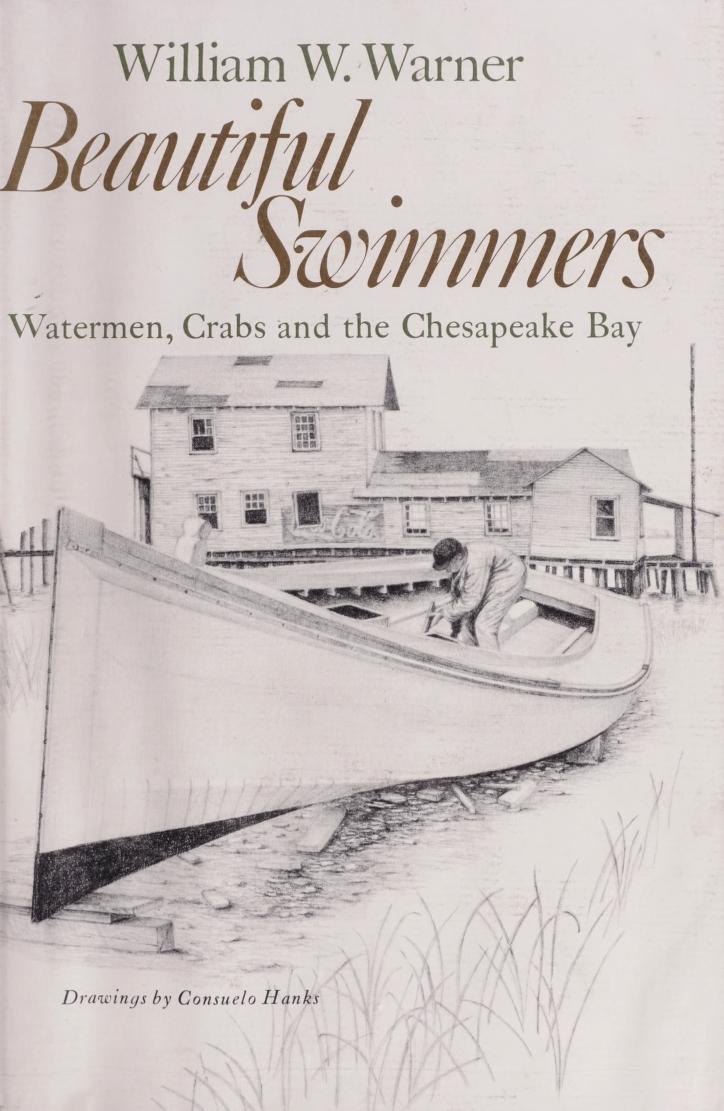Hardcover, 304 pages
English language
Published 1976 by Atlantic Monthly Press.

Hardcover, 304 pages
English language
Published 1976 by Atlantic Monthly Press.
In the tradition of Rachel Carson's The Edge of the Sea and Annie Dillard's Pilgrim at Tinker Creek, William W. Warner's Beautiful Swimmers is a book that delights and informs general readers and naturalists alike: a complete but humane natural history of the pugnacious, succulent Atlantic blue crab which, in both its hard- and soft-shell forms, graces millions of American tables; a study of the Chesapeake Bay — its history, its winds and tides, its gradations of depth, temperature, and salinity — which provides more crabs for human consumption than any other body of water in the world; and a colorful account of the watermen who make their living pursuing the blue crab.
The largest estuary in North America, Chesapeake Bay provides a perfect environment for marketable marine resources of incredible volume: clams, oysters, and most notable, the species of crab known to scientists as Callinectes sapidus (Callinectes is …
In the tradition of Rachel Carson's The Edge of the Sea and Annie Dillard's Pilgrim at Tinker Creek, William W. Warner's Beautiful Swimmers is a book that delights and informs general readers and naturalists alike: a complete but humane natural history of the pugnacious, succulent Atlantic blue crab which, in both its hard- and soft-shell forms, graces millions of American tables; a study of the Chesapeake Bay — its history, its winds and tides, its gradations of depth, temperature, and salinity — which provides more crabs for human consumption than any other body of water in the world; and a colorful account of the watermen who make their living pursuing the blue crab.
The largest estuary in North America, Chesapeake Bay provides a perfect environment for marketable marine resources of incredible volume: clams, oysters, and most notable, the species of crab known to scientists as Callinectes sapidus (Callinectes is Greek for "beautiful swimmers"; sapidus is Latin for "tasty"). And since its beginnings in the mid-nineteenth century, the Bay's crab fishery has made the United States the leading crab-consuming nation in the world, with fifty percent of our national blue crab catch coming from this area alone.
Beautiful Swimmers chronicles the seasons of the crabber's year, from autumn one year to the uproarious Labor Day Crab Derby the next. In between, the author describes not only the biology of the blue crab (including growth, moulting, migration, and the creature's particularly tender sex habits), but also the various ways crabs are caught, how they are picked and packed, and what becomes of them at crab houses and at the Fulton Fish Market. Warner introduces us to past and present work-boats: the skipjacks, scrapers, draketails, and log sailing canoes — boats that can only be seen on Chesapeake Bay — and takes us aboard with the independent, frank-talking watermen, both at work and at play. We listen to the "acid, down-at-the-heel witticisms" of some crabbers; hear them exchange news about their hauls over the marine radio; and marvel at the outrageous whoppers traded across the "liar's bench" on the Crisfield (Md.) county dock. And in another memorable, humorous account, we share the esprit of a fourth generation trotline crabber who prides himself on personally catching the crab the way it was done for over a century before the introduction of pots. (William Warner also includes an "Afterword" that suggests places to go and sights to see if you visit Chesapeake Bay and its crab fishery.)
Beautifully illustrated with drawings by Consuelo Barnes Hanks, Beautiful Swimmers is at once a brisk but full-dimensional evocation of a native American industry and a warm but unsentimental celebration of the particular men who make their living in it.